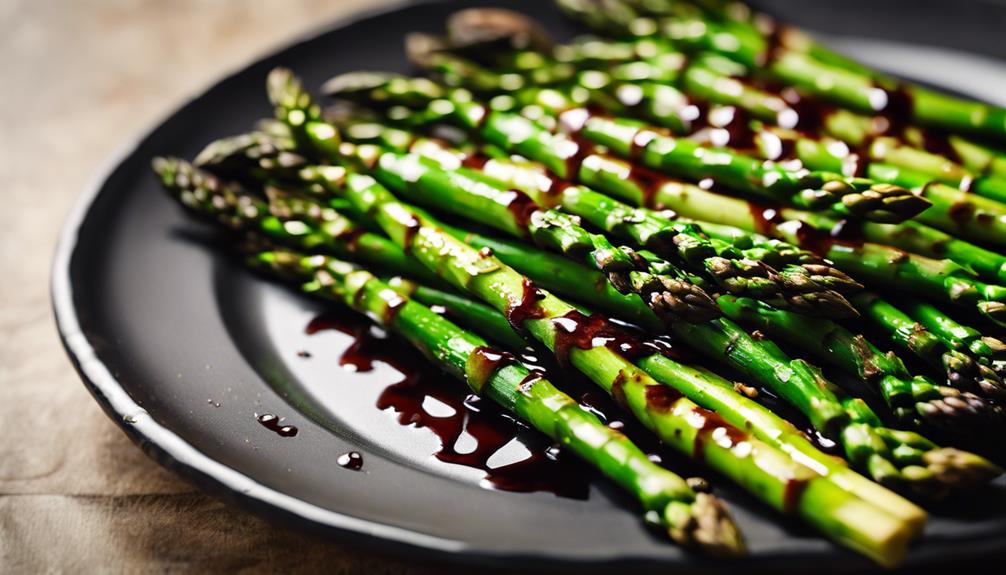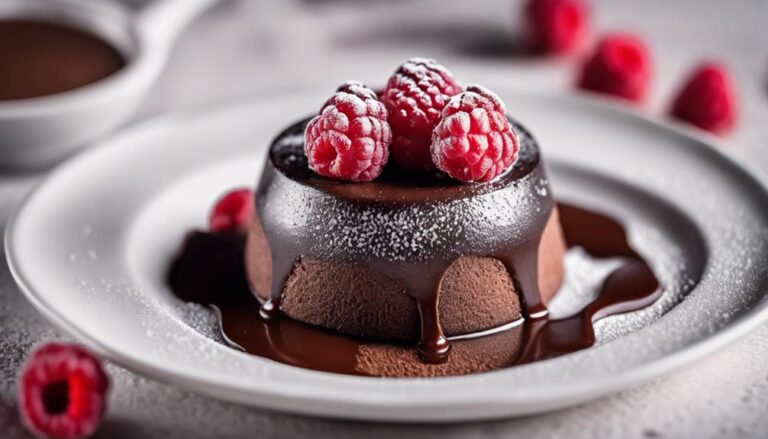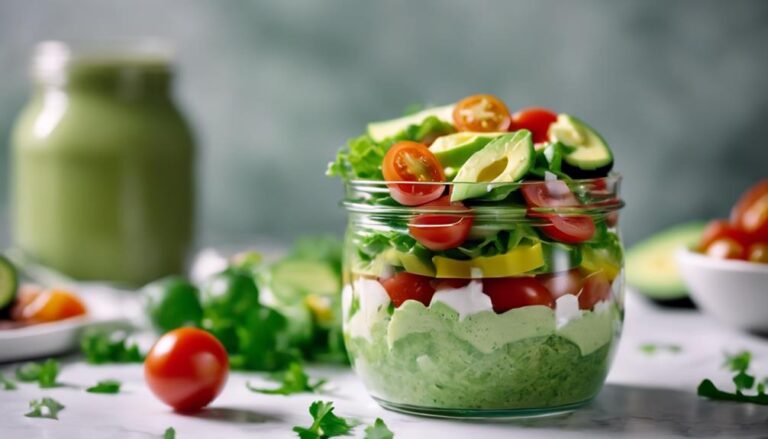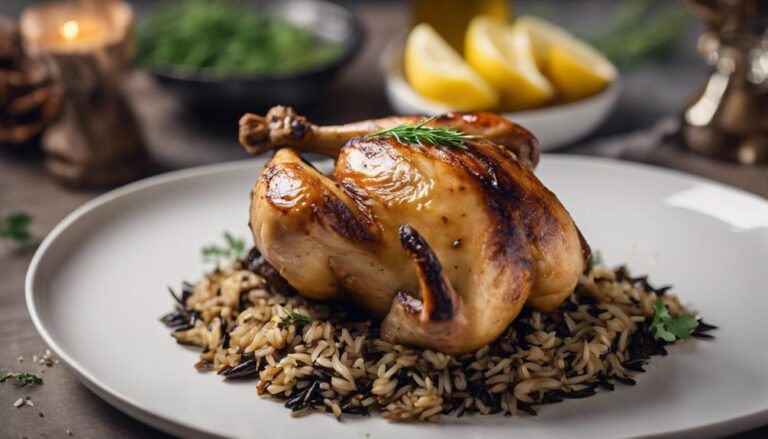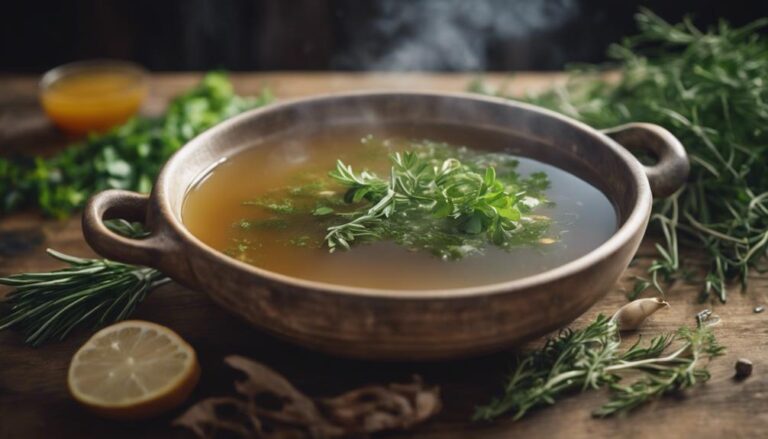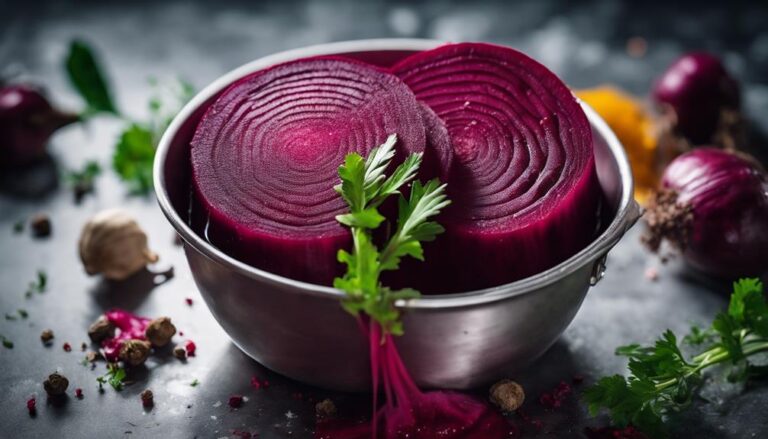Roasted Asparagus With Balsamic Reduction
To make roasted asparagus with balsamic reduction, preheat your oven to 400°F. Season the asparagus spears with salt, pepper, and olive oil. Roast thicker spears for 15-20 minutes until tender. Drizzle balsamic reduction for a sweet tangy finish. Experiment with different seasonings or cheeses for variety. Enjoy the earthy flavors and delightful combination of crispy asparagus with a hint of sweetness.
What You Will Learn Here
- Drizzle balsamic reduction over roasted asparagus for sweet tanginess.
- Ensure even coating of olive oil and seasoning before roasting for flavor.
- Pair roasted asparagus with balsamic reduction for a visually appealing dish.
- Experiment with different seasonings or Parmesan cheese for added taste.
- Roasted asparagus with balsamic reduction is a versatile side dish for various occasions.
Asparagus Cultivation Origins
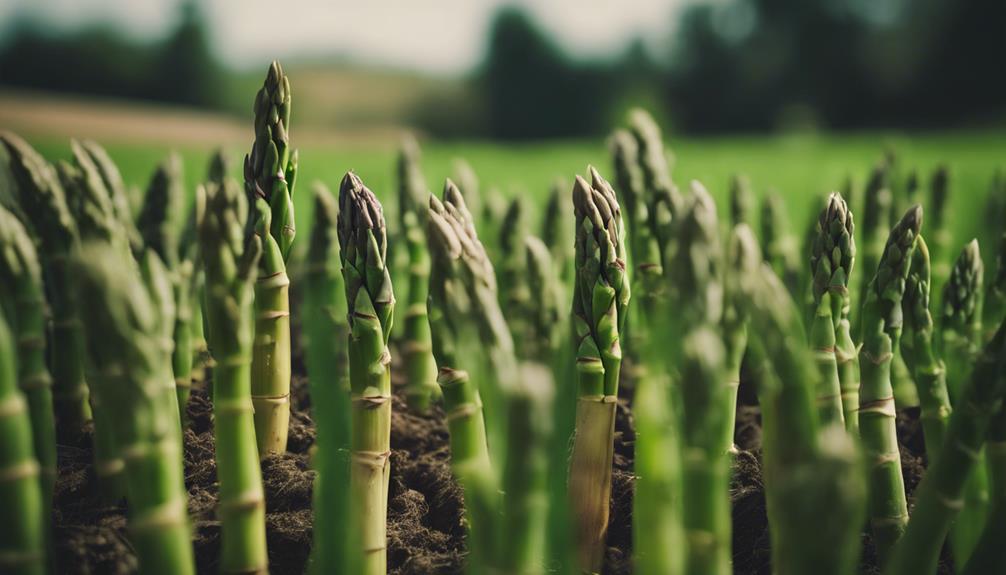
Asparagus cultivation has roots in ancient times, with a rich history that spans different varieties and farming techniques. Understanding the origins of asparagus cultivation provides insight into the evolution of this beloved vegetable.
Modern farming practices continue to build upon centuries of knowledge and innovation in growing asparagus.
Ancient Asparagus Cultivation
Having been cultivated for thousands of years, the origins of asparagus cultivation can be traced back to ancient civilizations. In ancient times, people developed various asparagus cultivation techniques using primitive methods. These early methods involved planting asparagus crowns in well-drained soil and carefully tending to the plants to guarantee a successful harvest. Asparagus was highly valued in ancient cultures for both its culinary appeal and its perceived medicinal properties. The historical significance of asparagus cultivation is evident in the writings of ancient civilizations like the Greeks and Romans, who documented the cultivation and consumption of asparagus in their texts.
The ancient methods of cultivating asparagus laid the foundation for modern techniques used today. Asparagus cultivation has evolved over the centuries, incorporating advancements in agriculture to improve crop yields and quality. The rich history of asparagus cultivation serves as a reminder of the enduring appeal of this versatile and nutritious vegetable.
Asparagus Varieties History
Rooted in ancient agricultural practices, the history of asparagus varieties reveals a fascinating journey of cultivation origins. Asparagus consumption trends have evolved over centuries, with this vegetable being prized by various ancient civilizations for its unique taste and potential health benefits. Asparagus, known for its tender spears and distinct flavor, has been cultivated in different varieties to enhance its attributes.
The nutritional benefits of asparagus have contributed to its popularity throughout history. Packed with vitamins, minerals, and antioxidants, asparagus is a nutritious addition to any diet. Its high fiber content supports digestive health, while the presence of folate promotes overall well-being.
Asparagus cultivation has adapted to meet changing consumer preferences and agricultural practices. The rich history of cultivating diverse asparagus varieties has laid the groundwork for the modern production methods we see today. Understanding the origins of asparagus varieties provides insight into the deep-rooted connection between this vegetable and human civilization.
Modern Asparagus Farming
With advancements in agricultural technology and practices, modern asparagus farming techniques have revolutionized the cultivation process. Sustainable practices and modern technology are now at the forefront of asparagus farming, ensuring efficient production while prioritizing soil health and water conservation. Farmers today utilize innovative irrigation systems that reduce water usage, helping conserve this precious resource and protect the environment. By implementing sustainable practices such as crop rotation and organic fertilization, modern asparagus farms promote soil health and biodiversity, ensuring the long-term viability of their operations.
Moreover, advancements in technology have enabled farmers to monitor crop growth more effectively, leading to higher yields and better quality asparagus. Drones are now used to survey fields and identify areas that may need attention, allowing for targeted interventions and reducing waste. Overall, modern asparagus farming combines traditional cultivation methods with cutting-edge technology to create a sustainable and efficient agricultural process that benefits both producers and consumers.
Asparagus Preparation Essentials
To prepare asparagus properly, start by selecting fresh, firm spears with tightly closed tips. Proper preparation is crucial to bring out the best flavors in this delicate vegetable. Here are some asparagus preparation essentials to make sure your dish turns out perfectly:
- Trimming: Before cooking, trim the tough ends of the asparagus by snapping them off or using a knife to cut them. This guarantees that you're left with only the tender, edible part of the spear.
- Peeling: For thicker asparagus spears, consider peeling the lower part of the stem to ensure even cooking. This step is optional but can help improve the texture of the asparagus.
- Washing: Rinse the asparagus under cold water to remove any dirt or debris. Pat them dry with a paper towel before proceeding with your chosen cooking method.
Asparagus Delightful Dishes

When it comes to asparagus dishes, you have a variety of delightful options to choose from.
Try making some Asparagus and Prosciutto Bundles for a tasty appetizer, or opt for the elegance of Balsamic-glazed Asparagus Spears.
If you're feeling adventurous, explore the flavors of a Balsamic-Infused Asparagus Medley to add a unique twist to your meal.
Asparagus and Prosciutto Bundles
For a delightful twist on asparagus, consider wrapping the spears in savory prosciutto slices. This elegant appetizer combines the freshness of asparagus with the rich flavor of prosciutto, creating a perfect harmony of tastes.
Here are some tips to make the most of your asparagus and prosciutto bundles:
- Asparagus pairing ideas: Asparagus pairs beautifully with a variety of ingredients. Try wrapping the asparagus in prosciutto and then grilling or roasting them for a smoky flavor. You can also add a sprinkle of Parmesan cheese before serving for an extra burst of flavor.
- Flavorful appetizers: These asparagus and prosciutto bundles make for a delightful appetizer that will impress your guests. The combination of the tender asparagus and the salty prosciutto is sure to please everyone's taste buds.
- Easy to make: Despite looking fancy, these bundles are easy to make. Simply wrap each asparagus spear in a slice of prosciutto and bake until the asparagus is tender. It's a quick and delicious dish that will elevate any meal.
Balsamic-glazed Asparagus Spears
Enhance your asparagus experience with the irresistible flavor of balsamic-glazed asparagus spears in this delectable dish. The combination of tender asparagus coated in a rich balsamic reduction creates a culinary masterpiece that will elevate any meal. Here are some tips and suggestions to make the most of your balsamic-glazed asparagus:
- Balsamic Reduction Tips: To achieve a perfect balsamic glaze, simmer balsamic vinegar over low heat until it thickens and develops a syrupy consistency. Add a touch of sweetness like honey or maple syrup for a balanced flavor profile.
- Flavor Profiles: The tangy sweetness of the balsamic reduction complements the earthy notes of asparagus, creating a harmonious blend of flavors. Consider adding a sprinkle of Parmesan cheese or toasted almonds for an extra layer of taste.
- Asparagus Serving Suggestions: Serve the balsamic-glazed asparagus spears as a side dish alongside grilled chicken or fish for a well-rounded meal. Pair them with creamy risotto or quinoa for a more substantial vegetarian option.
Balsamic-Infused Asparagus Medley
Indulge in the delightful flavors of balsamic-infused asparagus medley that will elevate your dining experience to new heights. This vibrant dish combines the earthy taste of asparagus with the rich sweetness of balsamic vinegar, creating a mouthwatering fusion of flavors that's sure to impress your taste buds.
Here are some tips to make the most of this delectable dish:
- Flavorful pairings: Experiment with different ingredients to find the perfect accompaniments for your balsamic-infused asparagus medley. Try adding cherry tomatoes for a burst of freshness or sprinkling some crumbled feta cheese on top for a creamy contrast.
- Cooking techniques: To enhance the flavors of the dish, consider grilling the asparagus instead of roasting it. Grilling adds a smoky char that complements the balsamic infusion beautifully. You can also try sautéing the asparagus with garlic and shallots for an extra depth of flavor.
- Presentation tips: When serving your balsamic-infused asparagus medley, garnish it with a sprinkle of fresh herbs like parsley or basil for a pop of color. You can also drizzle a little extra balsamic reduction on top for an elegant finishing touch.
With these simple tips, you can create a stunning balsamic-infused asparagus medley that will delight your senses and impress your guests.
Asparagus Roasting Techniques
When roasting asparagus, it's essential to pay attention to the oven temperature and cooking time to achieve the perfect balance of tenderness and flavor.
Seasoning your asparagus with the right blend of herbs and a drizzle of oil can elevate its taste and aroma.
Experimenting with different cooking methods like roasting, grilling, or sautéing can add variety to your asparagus dishes.
Oven Temperature and Time
For perfectly roasted asparagus, adjust the oven temperature and time according to your preference for tenderness and caramelization. When roasting asparagus, finding the right balance is vital to achieve the desired results.
To start, preheat your oven to 400°F (200°C) for a good balance between cooking time and browning. If you prefer a quicker cook with slightly less caramelization, you can increase the temperature to 425°F (220°C) but be mindful of potentially shorter cooking times. For a more gentle roast that allows the flavors to develop more slowly, you can opt for 375°F (190°C).
Timing is crucial when roasting asparagus. Generally, thinner asparagus spears will cook faster, taking about 10-15 minutes, while thicker spears may need 15-20 minutes. Keep an eye on the asparagus and adjust the time based on your desired level of doneness. Remember, these timings are just guidelines, and personal preferences play a significant role in achieving the perfect roasted asparagus.
Seasoning and Oil
To enhance the flavor of your roasted asparagus, season the spears generously with salt, pepper, and a drizzle of olive oil before placing them in the oven. Flavorful seasoning is crucial to bringing out the natural taste of the asparagus while quality oil helps to crisp up the spears and prevent them from sticking to the baking sheet.
Start by preheating your oven and preparing a baking sheet with parchment paper. Wash the asparagus and trim the tough ends before laying them out in a single layer. Drizzle olive oil over the spears, making sure each one is lightly coated. Sprinkle salt and pepper evenly to make certain all parts are seasoned.
The salt adds a savory element, enhancing the overall taste, while the pepper provides a subtle kick of heat. The olive oil not only helps with cooking but also brings out the earthy flavors of the asparagus. Once seasoned, pop the baking sheet into the oven and roast until the spears are tender-crisp and slightly caramelized.
Cooking Methods
Roasting asparagus offers a delicious way to bring out its natural flavors and textures, providing a satisfying cooking method that complements the vegetable's taste profile.
When grilling asparagus, preheat the grill to medium-high heat and cook the spears for about 5-7 minutes, turning occasionally until they're tender and slightly charred.
Steaming asparagus is a quick and healthy option; simply place the asparagus in a steamer basket over boiling water for 3-5 minutes until they're tender-crisp.
For stir fry, heat a pan over high heat with oil, add the asparagus, and cook for 3-5 minutes while stirring constantly until they're bright green and slightly tender.
Sautéing asparagus involves cooking them in a pan with oil or butter over medium-high heat for about 5-7 minutes until they're caramelized and tender. Experiment with these techniques to find your favorite way of cooking asparagus to enjoy its unique flavor and texture.
Final Thoughts
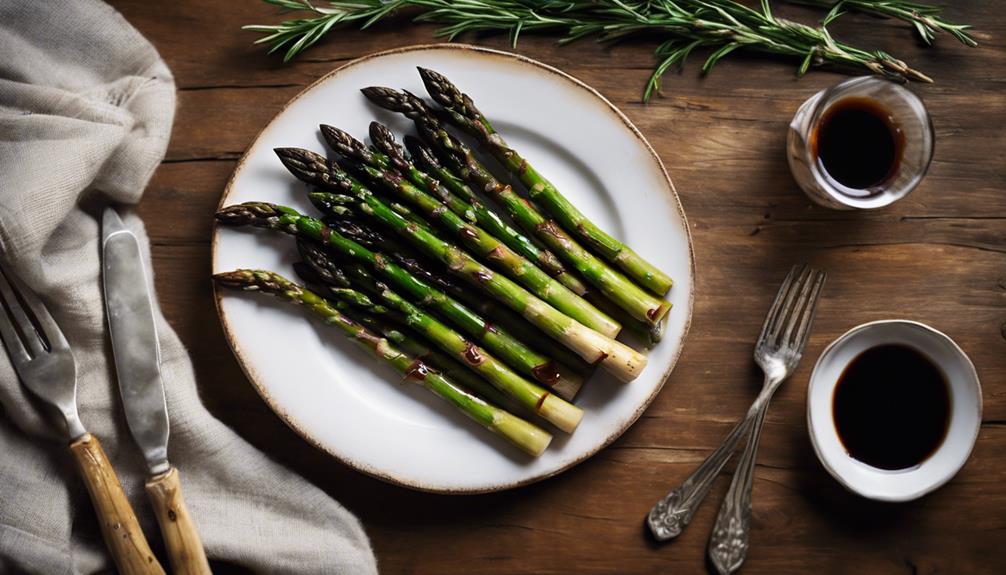
In wrapping up your roasted asparagus with balsamic reduction, consider pairing it with a light salad for a well-balanced meal. Reflections on this dish may bring to mind the simplicity of ingredients coming together to create a flavorful and elegant outcome. When preparing this recipe, culinary tips like ensuring the asparagus is evenly coated with olive oil and seasoning before roasting will enhance its taste.
Thinking about the final touches, drizzling the balsamic reduction over the roasted asparagus adds a sweet tanginess that complements the earthy flavors of the asparagus. This dish isn't only visually appealing but also a delightful sensory experience.
As you savor each bite, consider how the roasted asparagus with balsamic reduction can serve as a versatile side dish for various occasions. Whether it's a casual dinner or a special gathering, this dish is sure to impress with its vibrant colors and rich flavors. Experimenting with different seasonings or adding a sprinkle of Parmesan cheese can further elevate this already delicious dish. Enjoy the process of creating and sharing this delightful roasted asparagus with balsamic reduction with your loved ones.
Frequently Asked Questions
Can I Substitute Balsamic Vinegar With Another Type of Vinegar for the Reduction?
You can substitute balsamic vinegar with other vinegars for the reduction. Consider alternative vinegars like red wine or apple cider vinegar, but be mindful of their different flavor profiles that may affect the dish.
What Are Some Creative Ways to Garnish the Roasted Asparagus for Presentation?
For garnish options, consider sprinkling toasted breadcrumbs or shaved Parmesan. Plating techniques like a zigzag drizzle of olive oil or a sprinkle of fresh herbs add flair. Aim for color contrast and texture addition for a visually appealing dish.
How Can I Store Leftover Balsamic Reduction for Future Use?
To store leftover balsamic reduction for future use, transfer it to an airtight container and refrigerate. Storing tips include keeping it sealed to maintain freshness. Flavor variations can be achieved by adding herbs or spices before storing.
Are There Any Health Benefits Associated With Eating Roasted Asparagus?
Eating roasted asparagus offers numerous health advantages. Packed with nutritional benefits like fiber, vitamins, and antioxidants, it supports digestion and overall wellness. Explore different cooking methods and recipe variations to enjoy this nutritious vegetable in delicious ways.
Can Asparagus Be Roasted on a Grill Instead of in the Oven?
Yes, you can grill asparagus instead of using the oven. Grilling benefits include a smokier flavor and quicker cooking time. The oven vs grill debate often comes down to personal preference, but grilling can add a nice charred touch.
Conclusion
To sum up, roasted asparagus with balsamic reduction is a simple yet elegant dish that showcases the natural flavors of this versatile vegetable. By perfecting the art of roasting and combining it with a tangy balsamic reduction, you can create a delectable and impressive side dish that's sure to satisfy any palate.
So next time you're in search of a flavorful and nutritious addition to your meal, consider experimenting with this roasted asparagus recipe.
